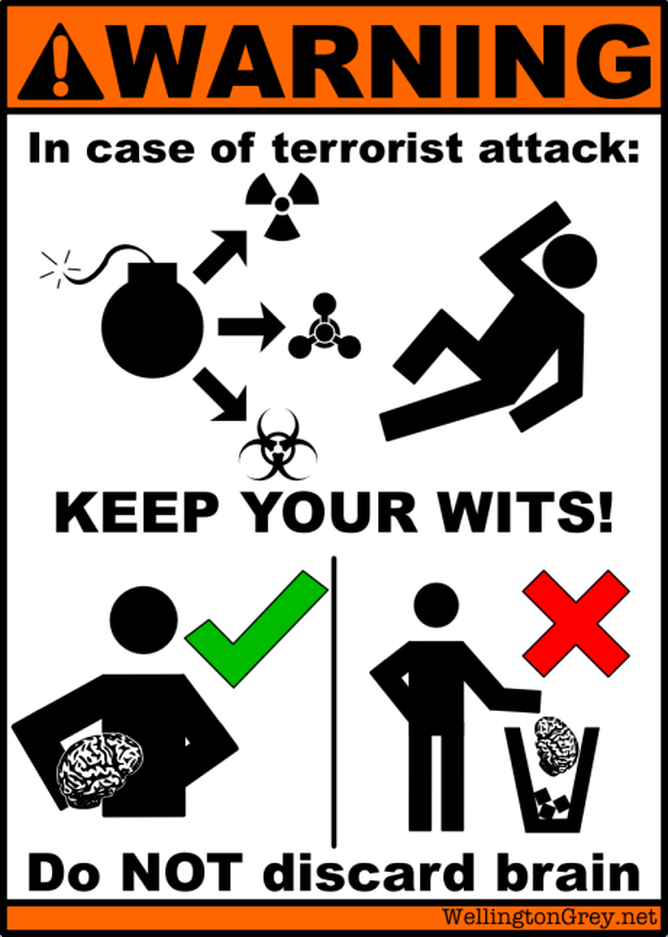The world has definitely changed, and being a New Zealander, it is likely that you are going to travel. Hopefully New Zealand is relatively immune from terror attacks, but that doesn't mean that as individuals we are.
The NZ Herald recently ran an article that you may not have seen, that talks about what to do in a terrorist attack, or when you are travelling to keep yourself safe. I have given you the link to that article below and have copied the key points below along with a personal tip.
SAFE TRAVEL REGISTER
One of my clients is closely involved in the Safe Travel notifications at the Ministry of Foreign Affairs and Trade, and every time I go overseas, she makes me promise to register on the website (and so I religiously do). The reason for this website is so that you can be found if there is a terrorist attack or a natural disaster, or in case there is an emergency back in New Zealand. Please take my clients advice and ensure that you register on this site (it makes our diplomats and officials jobs a lot easier) Go to: https://www.safetravel.govt.nz/
The NZ Herald full article can be accessed here http://nzh.tw/11874869.
Here are the tips from the article:
The worst thing that can happen in a terror situation is that you freeze or make ill-informed decisions, these personal safety techniques are designed to assist your decision-making process and help maximise your safety and that of those around you.
If each time you go out you mentally practice the techniques as detailed, they will soon become second nature.
Two basic types of cover
• The first is cover from view (this will only prevent you from being seen by an offender) and could involve hiding behind racks of clothing, shelving, desks, promotional hoardings or large rubbish bins, to name a few.
• Cover from fire is the second type of cover and relates to more robust structures designed to stop bullets such as thick cement walls or vehicle engine bays as examples. Basically, you are looking for anything that will stop the penetration of a bullet from a firearm.
Having determined which response will give you the greatest chance of survival we will now look at how we implement these two methods.
The current acknowledged best practice promotes a 3-stage response. This response would be conducted after your appreciation of the situation and includes the stages of 'Run, Hide, Call'.
In summary, this means: Run from the threat. If you can't run, hide, and finally when you are clear of the area or secured in a safe place, call emergency services. If you are unable to contact emergency services, contact a friend and let them know what you saw and where you are and get them to make contact on your behalf.
If you decide to run
• If you are in an unfamiliar environment and aren't sure which way is out, look for and follow staff in uniform, officials or locals as they will know the best exit.
• When running try and reduce your profile as much as you can, even if it's only hunching over slightly.
• Keep monitoring your surroundings, don't just run blindly. The situation may change quickly and you could end up running towards a new threat.
• Run in short bursts of 50-100m while going from cover to cover. Running in a straight line for a long time could make you an easy target.
• If the initial incident involved an explosive be aware there may be a secondary device. These would normally be placed near main exit routes or routes from venues or on main roads where the offenders would expect people fleeing to use. If you can use alternative back roads, alleys or safe secondary routes do so.
• Again, in the event of an IED, don't run to the most obvious meeting point, ie a nearby park, carpark or other central point. If it's obvious to you to go there then it will have been obvious to the offenders who may have placed a secondary device at that location.
• Be aware that some IEDs can be triggered by cell phones, so don't use your phone until you are clear of the area, unless you are unable to move and have no choice.
If you come across armed police while running away
• Do not run or charge directly at them, this may be a natural instinct but remember they will not know who you are and you could match a description of an offender.
• Do not grab at them.
• Drop anything you are holding that you may have had for protection.
• Do not reach into jackets or bags.
• Raise your hands.
• Follow their instructions.
If you decide the best option is to stay put
• Only stay if evacuating is not safe, the best option if possible is always to evacuate the area.
• Keep calm, use all your senses to determine what is happening.
• If you are with others ensure everyone keeps quiet.
• Look for somewhere that will separate you from the offenders, a separate room, secure hallway, garage or other location that will form a barrier between you and the offenders.
• If there are no rooms your only option may be to hide behind a counter, table, bar, car etc. Remember the offender may come in and look around so the more secluded or obscure your hiding place the better.
• Start considering what your options are should the offender come in, this may include running to an identified safe area or as a last option, fighting back. If the latter is your only choice remember there are no rules, do what you must to survive.
• If the room you are hiding in is dark, remove the light bulb if possible. If the offender opens the door they will not be able to see into the room.
• Lock or barricade yourself in. If safe to do so secure all doors and windows with whatever you can find to prevent someone pushing their way in or looking into your location. Do this quietly and in a manner that will not attract attention.
• Remain quiet and out of sight.
• Ideally your position should have a second secure but optional exit point.
• While playing dead has saved some people in the past, this is not generally recommended.
• Plan what you would do if the offender managed to break their way in. Options may include escaping via a secondary point, using a fire extinguisher to disorientate the offender or cover your escape, or even attacking the offender.
• Turn your phone to silent and dim the screen if in a darkened room.
• Text your location, how many people are with you, any injuries, what you saw and what you can see to several associates and the authorities.
• Be wary of anyone outside the door or in the venue walking around saying they are the police, generally tactical police units who are looking for an offender will not walk around advertising their presence.
If you are rescued by the police while hiding.
• Make sure you put down anything you are carrying that you were going to use as a weapon to defend yourself.
• Do not suddenly charge at the officers.
• Don't make any sudden movements.
• Do not reach into jackets or bags.
• Do not grab at them.
• Raise your hands.
• Follow their instructions


